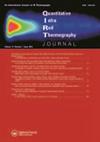一种新的基于中性粒细胞集的红外图像对比度增强算法
IF 4.9
3区 工程技术
Q1 INSTRUMENTS & INSTRUMENTATION
引用次数: 3
摘要
由于红外图像传感器阵列的热窗较窄,所表示的图像会变得模糊,细节也会变得模糊。采用不同的对比度和细节增强技术来提高图像质量。双边滤波增强算法是一种先进的红外图像增强方法,该算法首先将红外图像转换为基部和细节部,然后对细节部进行扩展和基部进行抑制,以增强红外图像的对比度。然而,这种方法不能有效地区分细节部分的背景和目标。因此,当细节部分展开时,噪声信息被放大,导致噪声增加,阻碍了细节部分的锐化。为了解决这些问题,提出了一种基于嗜中性集的增强算法,将细节部分转化为嗜中性域。我们的方法利用了中性域像素的三个隶属函数:T (True)、F (False)和I (indeacy),分别对应于图像的物镜、背景和过渡区域。对该算法进行了验证,并与已有算法进行了比较。实验结果表明,该算法可以有效地增强红外图像的对比度,并保留图像的细节。本文章由计算机程序翻译,如有差异,请以英文原文为准。
A novel algorithm for infrared image contrast enhancement based on neutrosophic sets
ABSTRACT Due to the narrow thermal window of infrared (IR) image sensor array, the represented image becomes dim and its details become blurred. Different contrast and detail enhancement technologies were deployed to improve image quality. An enhancement algorithm with bilateral filter is a state of art method, which first transforms an infrared image into a base part and a detail part, and then expands the detail part and suppresses the base part to enhancement the contrast of the IR image. However, this method cannot efficiently distinguish the background and objectives of the detail part. As a result, the noise information gets amplified when the detail part is expanded, leading to increase noise and to obstruct the sharpening of the detail part. To solve these problems, a novel enhancement algorithm based on the neutrosophic sets is proposed, which transforms the detail part into the neutrosophic domain. Our method utilises three membership functions of pixels in the neutrosophic domain: T (True), F (False) and I (Indeterminacy), which correspond to objective, background and transitional regions of image, respectively. The proposed algorithm is verified and compared with other existing algorithms. The experiment results show that the proposed algorithm can effectively enhance the contrast and preserve the details of an infrared image.
求助全文
通过发布文献求助,成功后即可免费获取论文全文。
去求助
来源期刊

Quantitative Infrared Thermography Journal
Physics and Astronomy-Instrumentation
CiteScore
6.80
自引率
12.00%
发文量
17
审稿时长
>12 weeks
期刊介绍:
The Quantitative InfraRed Thermography Journal (QIRT) provides a forum for industry and academia to discuss the latest developments of instrumentation, theoretical and experimental practices, data reduction, and image processing related to infrared thermography.
 求助内容:
求助内容: 应助结果提醒方式:
应助结果提醒方式:


